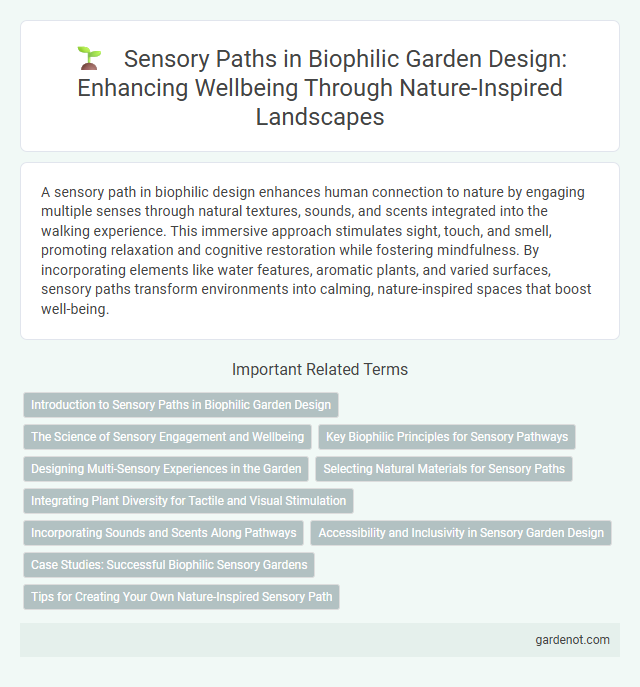A sensory path in biophilic design enhances human connection to nature by engaging multiple senses through natural textures, sounds, and scents integrated into the walking experience. This immersive approach stimulates sight, touch, and smell, promoting relaxation and cognitive restoration while fostering mindfulness. By incorporating elements like water features, aromatic plants, and varied surfaces, sensory paths transform environments into calming, nature-inspired spaces that boost well-being.
Introduction to Sensory Paths in Biophilic Garden Design
Sensory paths in biophilic garden design create immersive experiences that engage sight, sound, touch, and smell, enhancing human-nature connection. These paths incorporate diverse plant textures, natural materials, and ambient sounds to stimulate sensory perception and promote wellbeing. Integrating sensory paths fosters mindfulness and encourages exploration, making outdoor spaces more dynamic and restorative.
The Science of Sensory Engagement and Wellbeing
Sensory paths in biophilic design leverage multisensory stimuli to activate neural pathways that enhance cognitive function and emotional wellbeing. Research shows that exposure to natural textures, sounds, and scents within built environments reduces stress hormone levels and promotes restorative states. Integrating sensory engagement strategies supports mental health by fostering connection to nature and improving sensory processing.
Key Biophilic Principles for Sensory Pathways
Sensory pathways in biophilic design emphasize the integration of natural elements that stimulate sight, sound, touch, and smell to enhance human well-being. Key biophilic principles include the use of natural materials, organic shapes, textured surfaces, and ambient natural sounds that promote sensory engagement and environmental connection. These elements create immersive experiences that foster mindfulness, reduce stress, and support cognitive restoration.
Designing Multi-Sensory Experiences in the Garden
Designing multi-sensory experiences in the garden involves incorporating elements that engage sight, sound, touch, smell, and sometimes taste, creating an immersive biophilic environment. Features like textured plants, fragrant flowers, water sounds, and varied color palettes enhance sensory stimulation and foster emotional connection with nature. This sensory path approach not only promotes well-being but also encourages mindfulness and deeper interaction with outdoor spaces.
Selecting Natural Materials for Sensory Paths
Selecting natural materials for sensory paths enhances tactile engagement and visual harmony within biophilic design, fostering deeper human connection to nature. Materials like untreated wood, smooth river stones, and textured bark provide diverse sensory stimuli that stimulate touch, sight, and even sound. Incorporating sustainably sourced elements improves environmental impact while reinforcing the authenticity and immersive quality of sensory paths.
Integrating Plant Diversity for Tactile and Visual Stimulation
Integrating diverse plant species in a sensory path enhances tactile and visual stimulation, fostering a rich biophilic experience that engages multiple senses simultaneously. Varied textures, colors, and shapes of foliage invite touch and close observation, strengthening the connection to nature. This botanical diversity supports mental well-being by promoting sensory exploration and environmental immersion.
Incorporating Sounds and Scents Along Pathways
Incorporating natural sounds such as birdsong or flowing water along sensory paths enhances environmental engagement and reduces stress levels. Utilizing scents like lavender or pine can stimulate memory and evoke calming responses, contributing to a multi-sensory experience. Strategic placement of sound features and fragrant plants along pathways supports biophilic design principles by fostering deeper connections with nature.
Accessibility and Inclusivity in Sensory Garden Design
Sensory paths in biophilic design enhance accessibility by incorporating varied textures, sounds, and scents that engage multiple senses, catering to individuals with different abilities. Inclusive sensory garden design ensures features such as tactile maps, wheelchair-friendly surfaces, and adjustable sensory elements to accommodate diverse needs. Emphasizing universal design principles promotes equal access and meaningful interaction for all users within natural environments.
Case Studies: Successful Biophilic Sensory Gardens
Case studies of successful biophilic sensory gardens demonstrate the transformative impact of integrating natural elements to engage all five senses, enhancing mental well-being and environmental connection. Projects like the High Line in New York and the Eden Project in the UK showcase innovative use of plants, textures, sounds, and scents to create immersive sensory paths. These gardens improve stress reduction, cognitive function, and overall user experience, proving the efficacy of sensory-focused biophilic design in urban and therapeutic settings.
Tips for Creating Your Own Nature-Inspired Sensory Path
Incorporate diverse natural textures like smooth stones, soft moss, and rough bark to enhance tactile engagement along your sensory path. Position plants with varying scents such as lavender and eucalyptus to stimulate olfactory senses while maintaining a visually soothing color palette of greens and earth tones. Use natural materials like wood and gravel for walkways to promote grounding sensations and encourage mindful interaction with the environment.
Sensory path Infographic

 gardenot.com
gardenot.com